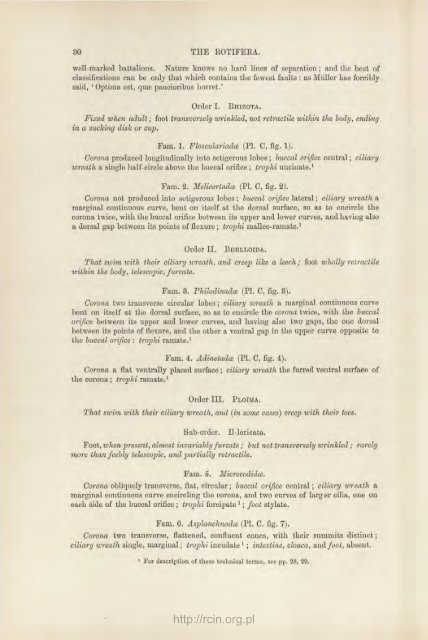Create successful ePaper yourself
Turn your PDF publications into a flip-book with our unique Google optimized e-Paper software.
well-marked battalions. Nature knows no liard lines of separation; and <strong>the</strong> best of<br />
classifications can be only that which contains <strong>the</strong> fewest faults : as Miiller has forcibly<br />
said, ' Optima est, qute paucioribus liorret.'<br />
Order I.<br />
RHIZOTA.<br />
Fixed when adult; foot transversely wrinkled, not retractile within <strong>the</strong> body, ending<br />
in a slicking disk or cup.<br />
Fam. 1. Flosculariadce (PI. C, fig. 1).<br />
Corona produced longitudinally into setigerous lobes ; buccal orifice central;<br />
wreath a single half-circle above <strong>the</strong> buccal orifice ; troplii uncinate. 1<br />
ciliary<br />
Fam. 2. Melicertadce (PI. C, fig. 2).<br />
Corona not produced into setigerous lobes ; buccal orifice lateral; ciliary wreath a<br />
marginal continuous curve, bent on itself at <strong>the</strong> dorsal surface, so as to encircle <strong>the</strong><br />
corona twice, with <strong>the</strong> buccal orifice between its upper and lower curves, and having also<br />
a dorsal gap between its points of flexure ; trophi malleo-ramate. 1<br />
Order II.<br />
BDELLOIDA.<br />
That swim with <strong>the</strong>ir ciliary wreath, and creep like a leech; foot wholly<br />
within <strong>the</strong> body, telescopic, furcate.<br />
retractile<br />
Fam. 3. Philodinadcz (PI. C, fig. 3).<br />
Corona two transverse circular lobes; ciliary ivreath a marginal continuous curve<br />
bent on itself at <strong>the</strong> dorsal surface, so as to encircle <strong>the</strong> corona twice, with <strong>the</strong> buccal<br />
orifice between its upper and lower curves, and having also two gaps, <strong>the</strong> one dorsal<br />
between its points of flexure, and <strong>the</strong> o<strong>the</strong>r a ventral gap in <strong>the</strong> upper curve opposite to<br />
<strong>the</strong> buccal orifice : trophi ramate. 1<br />
Fam. 4. Adinetada (PI. C, fig. 4).<br />
Corona a flat ventrally placed surface; ciliary wreath <strong>the</strong> furred ventral surface of<br />
<strong>the</strong> corona ; trophi ramate. 1 Order III. PLOIMA.<br />
That swim with <strong>the</strong>ir ciliary wreath, and (in some cases) creep with <strong>the</strong>ir toes.<br />
Sub-order. Il-loricata.<br />
Foot, when present, almost invariably furcate ; but not transversely wrinkled;<br />
more than feebly telescopic, and partially retractile.<br />
rarely<br />
Fam. 5.<br />
Microcodidce.<br />
Corona obliquely transverse, flat, circular; buccal orifice central; ciliary ivreath a<br />
marginal continuous curve encircling <strong>the</strong> corona, and two curves of larger cilia, one on<br />
each side of <strong>the</strong> buccal orifice ; trophi forcipate 1 ; foot stylate.<br />
Fam. 6. Asplanchnadce (PI. C. fig. 7).<br />
Corona two transverse, flattened, confluent cones, with <strong>the</strong>ir summits distinct;<br />
ciliary ivreath single, marginal; trophi incudate 1 ; intestine, cloaca, and foot, absent.<br />
http://rcin.org.pl
















